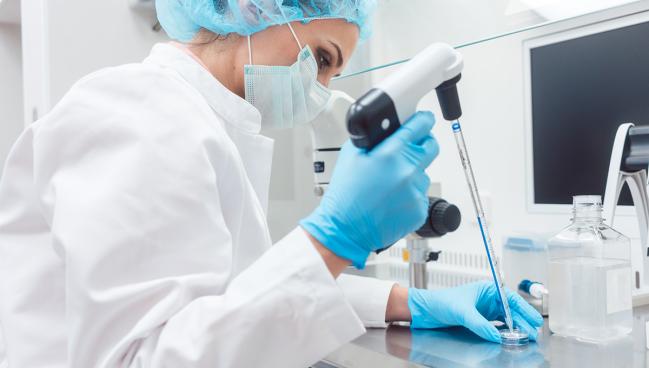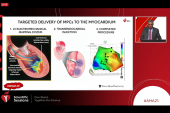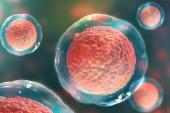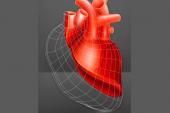Small Study Hints at Potential for HF Bone Marrow Cell Therapy: CardiAMP-HF
The trial was stopped early because of COVID-19 and low events but allowed researchers to identify responders for the next trial.

BOSTON, MA—A small study has shown some promising signals with cell therapy using bone marrow mononuclear cells for the treatment of patients with heart failure with reduced ejection fraction (HFrEF).
Overall, the intramyocardial injection of autologous bone marrow cells led to lower risks of cardiac mortality equivalents (need for a left ventricular assist device or heart transplantation) and nonfatal major adverse cardiovascular and cerebrovascular events (MACCE) over a mean follow-up of 20 months.
More importantly, investigators were able to identify a group of patients who responded best to treatment.
“When you look at a subgroup of patients, which is really the most exciting part of this, that had NT-proBNP levels of greater than 500 [pg/mL], which ended up being about 54 patients, those particular patients had quite a skew where the cell therapy group had a much more significant improvement,” lead investigator Amish Raval, MD (University of Wisconsin, Madison), who presented the results this week at THT 2024, told TCTMD.
While the overall lower risk of clinical events with cell therapy looks favorable, Raval emphasized that few definitive conclusions can be made from this small study. In fact, the CardiAMP Heart Failure trial, as it was known, was stopped early because of low enrollment and a lower-than-anticipated event rate in both groups. Initially planned to include 250 patients, the trial was unblinded after 110 patients had been randomized.
“I think the positive outcome from the pause is that it gave us some perspective on how to better redesign the [next] trial,” said Raval.
Bone Marrow Cells From Patient, Not Donor
Stem cell therapy to repair damaged heart muscle is in many ways still recovering from scandal. The field took a punch to the gut years back after it was revealed that Piero Anversa, MD, PhD, a former giant of stem cell research, falsified and/or fabricated data in more than 30 research papers. Anversa was at the forefront of cardiomyocyte regeneration research, publishing the first study showing that the bone marrow cells of mice contained stem cells, known as c-Kit+ cells, that could regenerate heart muscle.
The field, though, is rebuilding, with many companies investing in research using different cell types. Adult bone marrow contains stem and progenitor cells that can differentiate into hematopoietic, endothelial, and mesenchymal lines, with preclinical and early-phase studies of autologous bone marrow cell therapy demonstrating promising results, including in patients with heart failure.
I see a lot of positive signals. Amish Raval
“The field of cell therapy for heart disease in general and heart failure in particular dates back more than 20 years now with multiple different cell therapy types being tested using different delivery methods,” said Raval. That’s helped researchers identify the cell types most likely to have therapeutic benefits; however, “we've never actually landed on a clinical trial that has been robust enough to demonstrate full therapeutic efficacy, at least enough to support an FDA approval or commercialization of a product.”
In CardiAMP-HF, bone marrow was aspirated from the iliac crest during the screening period and the cellular aspirate was tested for its potential using a proprietary cell potency assay (CardiAMP). This assay tests for predefined markers of proangiogenic and regenerative potential, such as the number of CD34+ cells which have been shown to be associated with improvements in LVEF. Raval said the screening process allows them to select patients with bone marrow potency characteristics that seemed most favorable, noting that approximately 70% of patients tested will meet the benchmark for potency.
For the trial, investigators employed an adaptive trial design, which allowed them to observe and analyze outcomes at predetermined time points and to make changes to the study’s design based on their observations. After one of the periodic reviews, however, the data safety and monitoring board (DSMB) requested the trial be paused. Raval said a prespecified analysis for futility was not met, nor were there any safety concerns. Instead, low enrollment during COVID-19, coupled with the lower than anticipated event rate, led the company to stop the trial early and unblind the data.
Adaptive Design Study
The interim analysis at 24 months revealed a 37% relative reduction in risk of cardiac death equivalents and a 9% relative reduction in nonfatal MACCE. There was a trend toward fewer ventricular arrhythmias, as well as improved LVEF and lower NT-proBNP levels. These absolute and relative benefits were larger in patients with elevated NT-proBNP levels at baseline, as noted. There was no improvement in the 6-minute walk distance overall or in those with elevated NT-proBNP, but investigators believe this may be because they included patients with an ability to walk anywhere from 150 to 450 m at baseline.
To TCTMD, Raval said that from the perspective of clinical trial design, the ability to identify responders to treatment is important, which is something the adaptive interim analysis allowed them to do. “Having the DSMB reach in and provide us with that input was helpful,” he said. “But because we had unblinded, we just could not justifiably move forward with the existing trial the way it was. So, it's just going to be an entire redesign, with a new set of data going forward.”
Like this trial, CardiAMP-HF 2 will include patients with chronic ischemic LV dysfunction secondary to MI, NYHA functional class II and III symptoms, and LVEF between 20% and 40%. Patients will be randomized 3:2 to cell therapy or placebo on top of guideline-directed medical and device therapy for HF. This next trial, though, will include only those with NT-proBNP levels exceeding 500 pg/mL.
Asked about the chances for success, Raval was cautious.
“I've been doing clinical trials for a long time,” he said. “If we believe these point estimates that are so dramatic, then this would be a therapy that surpasses any pharmaceutical or device that’s out there now for chronic heart failure therapy. Whether it works or not, that's why we're doing the trial. I really don't want to hedge, but I see a lot of positive signals, though.”
Michael O’Riordan is the Managing Editor for TCTMD. He completed his undergraduate degrees at Queen’s University in Kingston, ON, and…
Read Full BioSources
Raval AN, Miller LW, Anderson RD, et al. Interim results from the adaptive controlled trial of autologous bone marrow mononuclear cells using CardiAMP cell therapy system in patients with ischemic heart failure due to reduced left ventricular ejection fraction. Presented at: THT 2024. March 4, 2024. Boston, MA.
Disclosures
- Raval reports no relevant conflicts of interest.





Comments